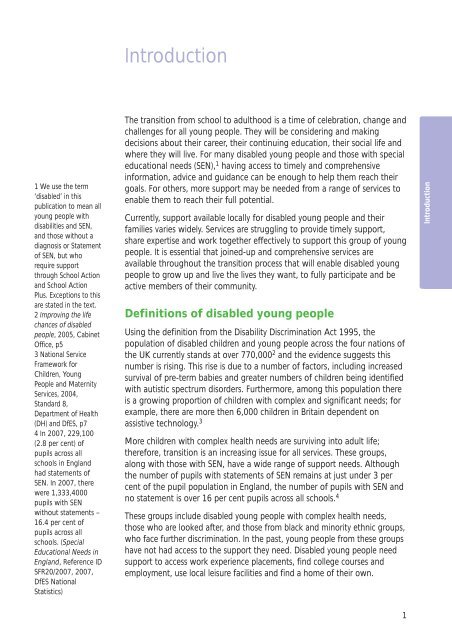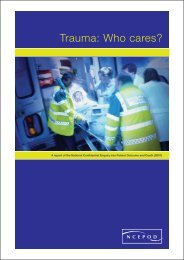AcknowledgementsWritten byHelen Wheatley, Principal Officer, Council <strong>for</strong>Disabled ChildrenLucia Winters, Development Officer, Council <strong>for</strong>Disabled Childrenwith Skill policy and In<strong>for</strong>mation Teams, inparticular, Amy Sweeney, Senior Policy Officer<strong>Transition</strong> <strong>Guide</strong> Reference GroupAlan Dyson, Professor of Education, University ofManchesterAlison Cowen, Consultant, Yorkshire andHumberside Regional PartnershipBarbara Waters, Chief Executive, SkillBeverly Burgess, Learning and Skills CouncilCathy Stephens, Facilitator, Yorkshire andHumberside Regional PartnershipClaire Lazarus, National Co-ordinator, RegionalPartnerships, Department <strong>for</strong> Education andSkills (<strong>for</strong>mer).David Abbott, Research Fellow, Norah FryResearch CentreDavid Widdas, Nurse Consultant <strong>for</strong> Childrenwith Complex Needs, North Warwickshire PCTEileen Visser, Ofsted officer with responsibility<strong>for</strong> SENFelicity McElderry, Professional Adviser, NationalAssociation of Paediatric Occupational TherapistsHazel Wright, Young People’s In<strong>for</strong>mation,Advice and Guidance Team, Connexions, DCSFJacqueline Shurlock, Disabled Children’s Team,Department <strong>for</strong> Education and Skills (<strong>for</strong>mer).Janet McDonagh, ARC Clinical Senior Lecturer inPaediatric and Adolescent Rheumatology,Institute of Child Health, Birmingham Children’sHospitalJohn Coleman, retired Director of the Trust <strong>for</strong>the Study of AdolescenceJudith Stone, Department of HealthJulie Haycock, Department <strong>for</strong> Children, Schoolsand FamiliesLesley Dee, Senior Lecturer in Inclusive Educationat the University of CambridgeLinda Jordan, Valuing People National SupportTeam, DHLouise Franklin, Department <strong>for</strong> Education andSkills (<strong>for</strong>mer).Margaret Palmer, Consultant, Eastern RegionalPartnershipNic Rowland Crosby, Consultant, ParadigmNigel Fulton, Department <strong>for</strong> Children, Schoolsand FamiliesPat Nicholls, Department of HealthPhilip Jones, Practice Development Coordinator(Social Care), SCIEPhilippa Russell, Disability Rights Commissioner,DRCRhidian Hughes, Social Care Institute <strong>for</strong>ExcellenceRobina Mallett, Home Farm TrustRussell Viner, Consultant in AdolescentMedicine, Institute of Child Health, UniversityCollege LondonFurther contributorsBridget Fisher, BME Unit Projects Manager, ARCCaroline Gray, Director of the ACE CentreAdvisory TrustCheryl Sharland, Assistant Director, Social Care,SuffolkChris Bush, Service Manager, Integrated DisabledChildren Service, Children and Young PeopleService Leicester (<strong>for</strong>mer)Christine Lenehan, Director, Council <strong>for</strong>Disabled ChildrenDaisy Russell, National Parent Partnership<strong>Network</strong> ManagerDebbie Brake, <strong>Transition</strong> Coordinator,Community <strong>Services</strong>, Coventry City CouncilDebbie Farthing, Team Manager, SandwellIntegrated Support ServiceJill Fardell, CEO, DARE foundationJoanna Marriott, Student In<strong>for</strong>mationCoordinator, SkillKate Jackson, <strong>Transition</strong>s Service DevelopmentManager, New Dimensions GroupKate Martin, Senior Development Officer,Council <strong>for</strong> Disabled ChildrenLeon Jordan, GenerateMargaret McGowan, Advisory Centre <strong>for</strong>EducationPatricia Halliday, Access-Ability ServiceManager, Connexions Hert<strong>for</strong>dshirePhilippa Stobbs, Principal Officer, Council <strong>for</strong>Disabled ChildrenRobin Miller, Service Manager <strong>for</strong> DisabledChildren, SandwellRuth Cartwright, Professional Officer, England,British Association of Social WorkersSteph Hawryla, Project Co-ordinator, YoungPeople Speaking Up!Steve Broach, Manager, Every Disabled ChildMatters CampaignTina Johnson, Youth Service, Disability SupportTeam, NottinghamshireTracey Cogan, Regional Change Agent <strong>for</strong>Children, Young People and Families, CSIPEastern Development CentreVictoria Wright, <strong>Network</strong> Administrator,<strong>Transition</strong> In<strong>for</strong>mation <strong>Network</strong>Vivien Freeman, Team Manager, Children withDisabilities Team, Westminster Children andCommunity <strong>Services</strong>viii
Introduction1 We use the term‘disabled’ in thispublication to mean allyoung people withdisabilities and SEN,and those without adiagnosis or Statementof SEN, but whorequire supportthrough School Actionand School ActionPlus. Exceptions to thisare stated in the text.2 Improving the lifechances of disabledpeople, 2005, CabinetOffice, p53 National ServiceFramework <strong>for</strong>Children, YoungPeople and Maternity<strong>Services</strong>, 2004,Standard 8,Department of Health(DH) and DfES, p74 In 2007, 229,100(2.8 per cent) ofpupils across allschools in Englandhad statements ofSEN. In 2007, therewere 1,333,4000pupils with SENwithout statements –16.4 per cent ofpupils across allschools. (SpecialEducational Needs inEngland, Reference IDSFR20/2007, 2007,DfES NationalStatistics)The transition from school to adulthood is a time of celebration, change andchallenges <strong>for</strong> all young people. They will be considering and makingdecisions about their career, their continuing education, their social life andwhere they will live. For many disabled young people and those with specialeducational needs (SEN), 1 having access to timely and comprehensivein<strong>for</strong>mation, advice and guidance can be enough to help them reach theirgoals. For others, more support may be needed from a range of services toenable them to reach their full potential.Currently, support available locally <strong>for</strong> disabled young people and theirfamilies varies widely. <strong>Services</strong> are struggling to provide timely support,share expertise and work together effectively to support this group of youngpeople. It is essential that joined-up and comprehensive services areavailable throughout the transition process that will enable disabled youngpeople to grow up and live the lives they want, to fully participate and beactive members of their community.Definitions of disabled young peopleUsing the definition from the Disability Discrimination Act 1995, thepopulation of disabled children and young people across the four nations ofthe UK currently stands at over 770,000 2 and the evidence suggests thisnumber is rising. This rise is due to a number of factors, including increasedsurvival of pre-term babies and greater numbers of children being identifiedwith autistic spectrum disorders. Furthermore, among this population thereis a growing proportion of children with complex and significant needs; <strong>for</strong>example, there are more then 6,000 children in Britain dependent onassistive technology. 3More children with complex health needs are surviving into adult life;there<strong>for</strong>e, transition is an increasing issue <strong>for</strong> all services. These groups,along with those with SEN, have a wide range of support needs. Althoughthe number of pupils with statements of SEN remains at just under 3 percent of the pupil population in England, the number of pupils with SEN andno statement is over 16 per cent pupils across all schools. 4These groups include disabled young people with complex health needs,those who are looked after, and those from black and minority ethnic groups,who face further discrimination. In the past, young people from these groupshave not had access to the support they need. Disabled young people needsupport to access work experience placements, find college courses andemployment, use local leisure facilities and find a home of their own.Introduction1
















